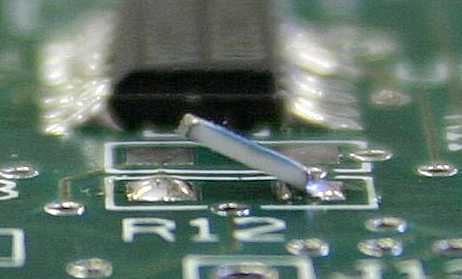Tombstoning Issues
Issue Description: Components lift up during reflow causing an open at one end. This typically occurs when one solder paste deposit reflows before the other. Tomstoning is commonly found on circuit boards that have a ground plane attached to one end of a small component. This creates a temperature difference from end to end of the component during reflow.
 1) Use a solder paste formulated to minimize tombstoning. We offer a variety of Anti-tombstoning solder pastes.
1) Use a solder paste formulated to minimize tombstoning. We offer a variety of Anti-tombstoning solder pastes.
Anti-tombsoning solder pastes are typically made by using a mixture of alloys in order to create a melting range. The force generated by reflow and coalescence of the solder powder is equalized at both ends of a component when alloys with a melting range are used. For example, the addition of silver to a eutectic solder like Sn63/Pb37 creates a melting range.
Solder paste with higher tack force can also be used to help hold the component until reflow is complete on both ends. Higher tack force is typically generated through the use of high solids content fluxes.
2) Modify the reflow profile to equalize temperature variations across the trouble components.
Use of a longer soak time can even heating from end to end of a component.
Reducing the ramp rate generates a longer soak time, and also helps equalization of temperatures across the circuit board.
3) Modify the stencil to equalize the solder paste deposit across the trouble components.
Moving the solder paste deposit toward the middle of the component and away from the ends, results in less force on the outside edge during reflow. This reduces the potential for tombstoning.
Reduction of solder paste volume on the end of the component that is lifting up will speed up the reflow of that deposit. When the solder paste deposits at both ends of the component reflow at the same time, then tombstoning is eliminated.

